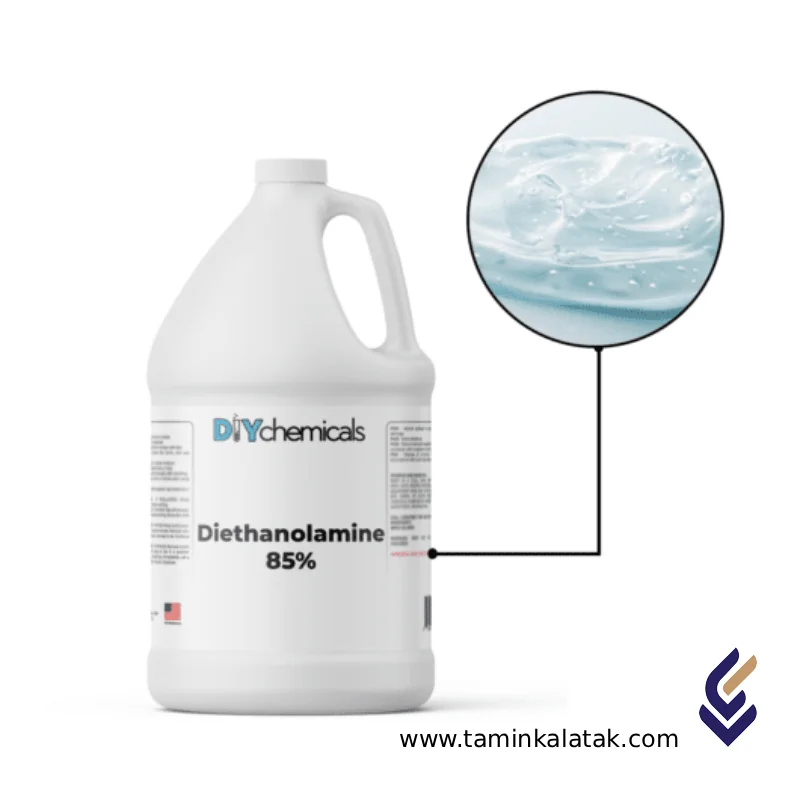DEIPA 85%
Diethanolamine (DEA) is a secondary amine with the chemical formula C₄H₁₁NO₂, typically supplied at 85% concentration.
It is a colorless to pale-yellow viscous liquid with a mild ammonia-like odor.
DEA is widely used in resin manufacturing, gas treatment, detergents, paints, pharmaceuticals, and various industrial formulations.
In industrial processes, it acts as a pH adjuster, catalyst, neutralizing agent, and emulsifier.
Chemical Structure
-
Molecular Formula: C₄H₁₁NO₂
-
Molecular Weight: 105.14 g/mol
-
Structure: Contains two hydroxyl (-OH) groups and one secondary amine (-NH) group.
Solidifies into deliquescent crystals that form a viscous liquid upon melting.
Physical and Chemical Properties
| Property | Typical Value |
|---|---|
| Physical State | Viscous liquid or meltable crystals |
| Color | Colorless to pale yellow (≤15 APHA) |
| Odor | Ammoniacal / fishy |
| Density (20 °C) | 1.09 g/mL |
| Melting Point | ≈ 28 °C |
| Boiling Point | ≈ 268 °C (at 1 atm) |
| Viscosity (30 °C) | ≈ 352 cP |
| Vapor Pressure (20 °C) | < 0.01 mmHg (~0.00037 hPa) |
| Solubility in Water | Completely miscible |
| Refractive Index (nᴅ) | ≈ 1.477 |
| pKa (25 °C) | ≈ 8.9 |
| Explosion Range (air) | 1.6–9.8% (v/v) |
| Ecotoxicity | Harmful to aquatic life with long-term effects |
Key Advantages
-
Bifunctional molecule — contains both amine and hydroxyl groups, enabling diverse chemical reactivity.
-
Effective pH regulator and catalyst in resin production, polyurethane foams, detergents, agrochemicals, and cosmetics.
-
High solubility in water and polar solvents; easily blends with various formulations.
-
Capable of absorbing acidic gases (CO₂, H₂S) in gas treatment systems.
Limitations and Hazards
-
Corrosive to skin and eyes — may cause severe burns or tissue damage.
-
Toxic upon chronic exposure — prolonged inhalation or contact may harm the liver, kidneys, or blood system.
-
Oral LD₅₀ (rat): ≈ 1.6 g/kg
-
-
Harmful to aquatic organisms — must be neutralized or diluted before disposal.
-
Incompatible with strong acids, oxidizers, and acid chlorides (may cause exothermic reactions).
Industrial Applications
-
Gas Sweetening:
Absorption of CO₂ and H₂S from natural gas and process streams. -
Paints, Resins & Adhesives:
Used as a catalyst, stabilizer, and neutralizing agent in epoxy and alkyd systems. -
Detergents & Personal Care:
pH adjustment, foam stabilizer, and emulsifier in soaps and cosmetic formulations. -
Pharmaceutical & Cosmetic Industry:
Intermediate in the production of emollients, conditioners, and surface-active agents. -
Agrochemicals:
Solvent and intermediate for fertilizers and pesticide formulations. -
Other Uses:
Emulsion additive in photographic chemicals and cement admixtures to enhance performance.
Safety and Handling
Main Hazards:
-
Strong irritant to skin and eyes
-
May be absorbed through the skin and cause systemic toxicity
-
Harmful to aquatic environments
Personal Protective Equipment (PPE):
-
Chemical-resistant gloves and protective clothing
-
Safety goggles or face shield
-
Adequate ventilation or respiratory protection (P2/P3 filter) in confined spaces
Storage Conditions:
-
Store in a cool, dry, well-ventilated area
-
Keep away from acids, oxidizing agents, and heat sources
-
Maintain temperature below the melting point (≈ 28 °C) to prevent solidification
-
Use tightly sealed containers with clear labeling
Emergency Measures:
-
Skin contact: Wash immediately with plenty of water and soap
-
Eye contact: Rinse continuously with water for at least 15 minutes and seek medical attention
-
Inhalation: Move victim to fresh air; administer oxygen if necessary
-
Spill cleanup: Absorb with inert materials and dispose according to environmental regulations
Summary:
Diethanolamine (DEA 85%) is a versatile industrial chemical with strong pH-regulating, emulsifying, and gas-absorbing properties.
It plays a critical role in gas purification, resin synthesis, detergents, and personal care formulations.
Proper handling, protective measures, and controlled use are essential due to its corrosive and toxic nature.
Applications
| Applications | , , , |
|---|
DEIPA 85%
| Products | Grade | Chemical formula | Appearance | Density | Applications | Data Sheet | MSDS |
|---|---|---|---|---|---|---|---|
| DEIPA 85% | C₉H₂₁NO₃ | Clear to pale yellow liquid | 1.04 g/cm³ | ||||
| DEIPA 85% | |||||||
| DEIPA 85% |







